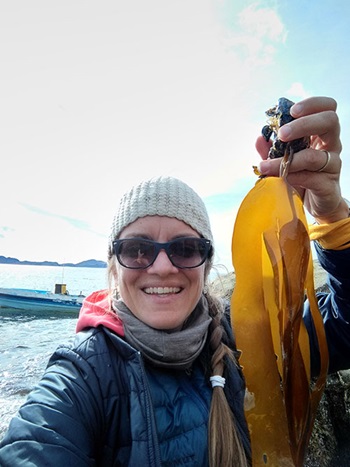Seaweed grown in Greenland is a safe, healthy and sustainable food source that could replace up to 20% of the country’s import of vegetables, according to a study from the National Food Institute, Technical University of Denmark.
Seaweed has traditionally been a regular part of the Greenlandic diet, but over time, imported vegetables have become popular leading to seaweed being a rare feature nowadays in the average diet.
Replacing some of the imported goods with naturally occurring Greenlandic seaweed, which in many ways has a nutrition profile that is similar to various vegetables, would have a positive effect on the climate impact of the diet. A PhD study from the National Food Institute has therefore studied 10 different Greenlandic seaweed species to assess whether they are suitable for human consumption.
Seaweed is generally nutritious and safe to eat
Most of Katharina Johanna Kreissig’s fieldwork was conducted on the west coast of Greenland near Arctic DTU's campus in Sisimiut. Her analyses show that Greenlandic seaweed species are generally full of healthy nutrients such as calcium, magnesium, iron and omega-3 fatty acids. At the same time, they contain insignificant amounts of various heavy metals such as arsenic, cadmium, lead and mercury.
However, the large leaved seaweed species are generally high in iodine. To avoid an excessive iodine intake, it would be necessary to process these kelp species to reduce the iodine content. For seaweed that grows close to sewage outlets, the study also shows a risk of unacceptable levels of disease-causing microorganisms. Therefore, seaweed harvested from such areas should not be used as food.
Katharina Johanna Kreissig estimates that Greenlandic seaweed could potentially replace between 5-20% of Greenland's imports of vegetables (e.g. as substitutes for frozen spinach or Asian seaweed salad).
She also believes that Greenlandic seaweed could become a valuable export commodity. “The knowledge generated in this project about the makeup of the seaweed provides a basis for Greenlanders to benefit more from this underutilized, nutrient-rich, aquatic resource,” Katharina Johanna Kreissig says.

Image text: Katharina Johanna Kreissig during fieldwork in Qerrortusoq with a handful of qernaluk/Hedrophyllum nigripes. Photo: Katharina Johanna Kreissig
Read more
Find out more about the analyses of heavy metals in the different seaweed species in a scientific article in the publication PLOS ONE: Characterisation and chemometric evaluation of 17 elements in ten seaweed species from Greenland.
Download Katharina Johanna Kreissigs ph.d.-thesis via DTU’s forskningsdatabase DTU Orbit: Greenland seaweeds for human consumption. The work was financed by the Greenland Research Council and funds from SW-GROW, aNorthern Periphery and Arctic Programme projekt (EU).
You can also visit a new special topic portal on the National Food Institute’s website, which showcases the many ways in which the institute works to create sustainable technological solutions in the area of food.
Replacing some of the imported vegetables with Greenlandic seaweed would support the Sustainable Development related to ensuring sustainable consumption and production patterns (goal 12) and conserving and sustainably using the oceans, seas and marine resources (goal 14).